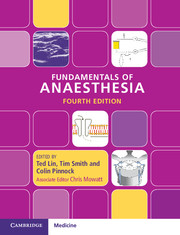Book contents
- Fundamentals of Anaesthesia
- Fundamentals of Anaesthesia
- Copyright page
- Dedication
- Contents
- Contributors
- Preface to the first edition
- Preface to the second edition
- Preface to the third edition
- Preface to the fourth edition
- Acknowledgements
- Abbreviations
- Section 1 Clinical anaesthesia
- Section 2 Physiology
- Chapter 10 Cellular physiology
- Chapter 11 Body fluids
- Chapter 12 Haematology and immunology
- Chapter 13 Muscle physiology
- Chapter 14 Cardiac physiology
- Chapter 15 Physiology of the circulation
- Chapter 16 Renal physiology
- Chapter 17 Respiratory physiology
- Chapter 18 Physiology of the nervous system
- Chapter 19 Physiology of pain
- Chapter 20 Gastrointestinal physiology
- Chapter 21 Metabolism and temperature regulation
- Chapter 22 Endocrine physiology
- Chapter 23 Physiology of pregnancy
- Chapter 24 Fetal and newborn physiology
- Section 3 Pharmacology
- Section 4 Physics and clinical measurement
- Index
- References
Chapter 20 - Gastrointestinal physiology
from Section 2 - Physiology
Published online by Cambridge University Press: 19 January 2017
- Fundamentals of Anaesthesia
- Fundamentals of Anaesthesia
- Copyright page
- Dedication
- Contents
- Contributors
- Preface to the first edition
- Preface to the second edition
- Preface to the third edition
- Preface to the fourth edition
- Acknowledgements
- Abbreviations
- Section 1 Clinical anaesthesia
- Section 2 Physiology
- Chapter 10 Cellular physiology
- Chapter 11 Body fluids
- Chapter 12 Haematology and immunology
- Chapter 13 Muscle physiology
- Chapter 14 Cardiac physiology
- Chapter 15 Physiology of the circulation
- Chapter 16 Renal physiology
- Chapter 17 Respiratory physiology
- Chapter 18 Physiology of the nervous system
- Chapter 19 Physiology of pain
- Chapter 20 Gastrointestinal physiology
- Chapter 21 Metabolism and temperature regulation
- Chapter 22 Endocrine physiology
- Chapter 23 Physiology of pregnancy
- Chapter 24 Fetal and newborn physiology
- Section 3 Pharmacology
- Section 4 Physics and clinical measurement
- Index
- References
Summary
The gastrointestinal (GI) tract extends from the mouth to the anus. It represents a series of organs with specialised roles, motor patterns and secretory functions. Its primary purpose is the absorption of water and nutrients. Food is moved along its length and mixed with secretions that aid digestion. Nutrients are absorbed across the gut wall and waste products and indigestible residue excreted as faeces.
- Type
- Chapter
- Information
- Fundamentals of Anaesthesia , pp. 454 - 465Publisher: Cambridge University PressPrint publication year: 2016



